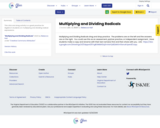
This click and drag activity is a great practice for Algebra II students on multiplying and dividing radical expressions.
- Subject:
- Algebra I & II
- Mathematics
- Material Type:
- Activity/Lab
- Assessment
- Homework/Assignment
- Date Added:
- 12/23/2019

This click and drag activity is a great practice for Algebra II students on multiplying and dividing radical expressions.
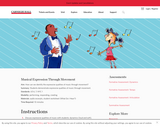
Students demonstrate expressive qualities of music through movement.

Students explore first and second endings by singing and moving.
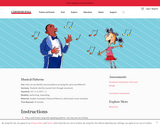
Students identify musical form through movement.
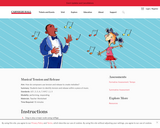
Students learn to identify tension and release within a piece of music.

This assessments fulfills the requirement for a VAAP local alternative assessment for writing 5-reporting category- research, plan, compose, and revise for a variety of purposes.
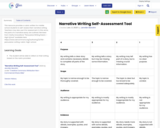
This resource provides a rubric written for middle school students to self-assess their narrative writing. Teachers may also use it for assessment. In this remix, the parts of a narrative essay are outlined.
Remixed from Clarity Innovations' "Persuasive Writing Rubric--High School" available here: https://www.oercommons.org/authoring/22756-persuasive-writing-rubric-high-school.
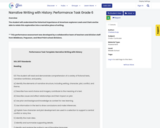
The student will understand the historical importance of American explorers Lewis and Clark and be able to relate this exploration into a narrative piece of writing. ** This performance assessment was developed by a collaborative team of teachers and division staff from Middlesex, Poquoson, and West Point school divisions.

This activity is to be used after they have been taught native American resources. Students will need to fill in a Google Drawings chart for the Native American Resources by dragging each photo into the rectangle that it belongs to. When they are done, they will fill out the chart asking for them to justify their descions. They will need to describe what the photo is and why they put the photos in each rectangle. After they have explained, they will need to write the name of the tribe the resource belonged to (Inuit, Lakota, Iroquois, Pueblo, or Kwakiutl).

Natural disasters such as volcanoes, earthquakes, hurricanes, and wildfires happen all over the world. Understanding how natural disasters happen and why helps children feel less anxious and more prepared. Therefore, this unit focuses on teaching students the science behind each natural disaster while also explaining what to do if they live in an area prone to a particular natural disaster. Over the course of the unit, students hear about many famous natural disasters, but the unit places more of an emphasis on how the disasters happen rather than exploring the devastation or destruction caused by previous natural disasters. The unit provides many opportunities for students to learn more about recent natural disasters, including a culminating research project.
The texts in this unit were chosen because of their wide variety of text features, content, and accessibility. Over the course of the unit, students will read texts that are very technical and rely heavily on text features, diagrams, and illustrations, as well as texts that are written as informational narratives. Students will be challenged to think about the structures the authors use to help the reader interact with and learn the content. Additionally, students will learn the importance of referring to specific details from the text and using those details to explain and teach back the newly learned material. This unit serves as the foundation for building strong reading habits and routines and setting high expectations for text consumption. Clear models should be included in the unit to help students build a deeper understanding of how to actively read and annotate informational texts for key ideas, text features, and vocabulary. This unit also serves as a launching point for strong discussions. Students will frequently be challenged to debate questions from the text; therefore, strong habits of discussion need to be introduced over the course of the unit.

This is an unplugged version of how computer data packets travel through computer networks using rope, binder clips, envelopes and index cards.
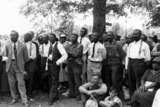
This inquiry focuses on the uneven impacts of the New Deal policies with a focus on the experiences of everyday Americans living in the South. It is intended to expand students’ existing understanding of the New Deal by engaging in analysis around issues of equity and perspective. The questions, tasks, and sources in this inquiry asks students to consider the impact of three areas of federal policy during the New Deal (agricultural, employment benefits, and housing) and to consider how those policies may have been interpreted by Southerners at the time.
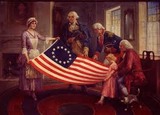
This is a fun interactive that can be used to assess students on the “New Nation” unit OR to review the unit.
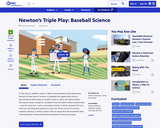
This resource teaches students about balanced forces, unbalanced forces, and Newton's three laws through the game of baseball. It is interactive and uses short videos and simulations to help students learn the content. It culminates with a project at the end.

Final test after completing the book

All parts of a novel unit for Refugee by Alan Gratz

This lesson takes simple nursery rhymes and gives the students the opportunity to build on multiple use vocabulary and context vocabulary skills
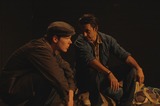
Title: Of Mice and Men Unit - Summative PBA Topic: The American Dream, Of Mice and Men (After Reading)Educational Standards: SOL 11.4Subject Area: English 11

This resource provides eight multiple-choice questions which were modeled after question stems frequently appearing on the End of Course (EOC) Reading Standards of Learning (SOL) test. It is designed to be used with the poem "One Art" by Elizabeth Bishop.
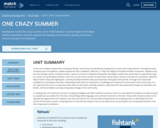
In this unit, students explore the meaning of family, community, and identity by reading the core text One Crazy Summer. Through the eyes of eleven-year-old Delphine, readers experience life in Oakland, California, in 1968, the height of the Black Panther movement. Delphine and her two younger sisters, Vonetta and Fern, spend a summer in Oakland visiting their estranged mother who sends them to spend their days at a camp run by the Black Panthers. Over the course of the summer, the girls learn about what it means to be part of a revolution, what the Black Panther Party was fighting for, and why the Black Panther Party was important during this time period. Through it all, they build confidence in themselves and their relationships with others as they learn to challenge and respond to social issues in the community. It is our hope that this unit, in conjunction with others in the series, will help students understand the way experiences shape our identities and beliefs, and how children can help bring about change in the community.
In reading, this unit continues to build on reading strategies and skills covered in previous units. It is assumed that students are able to quote or paraphrase accurately from the text, interpret figurative language, and summarize sections of the text. These skills should continue to be spiraled throughout the unit; however, the main focuses for this unit are determining theme and analyzing how it is developed over the course of the novel or poem, analyzing point of view and the impact it has on the way events are portrayed, and comparing characters and their responses to situations.